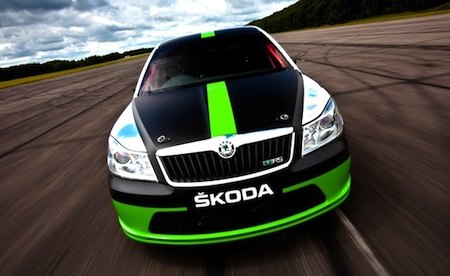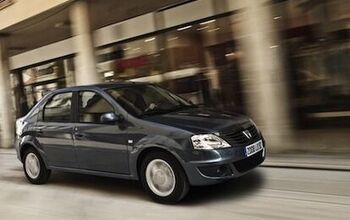Best Selling Cars Around The Globe: Skoda King At Home In Czech Republic
Over the past couple of weeks, we have traveled to Iceland, The Entire World (yep!), France and Germany. This week again we won’t go too far and cross just another border to land in the Czech Republic.
Now if beer, beer, Prag and beer are not your thing, I don’t believe you – but hey that’s fine because I have prepared 159 additional countries for you to visit in my blog, so don’t be shy and click away!
The Czech Republic is, logically, the kingdom of Skoda, but with Skoda’s range expanding every year the brand now has a stronger hold than ever on the best-selling models ranking…
Car sales in Czech Republic are up 2 percent in 2011 at 173,282 units and Skoda monopolizes the podium like in 2010:
The Skoda Octavia is the best-selling model in the country for the third consecutive years albeit with sales down 8 percent to 23,661 units and 13.7 percent share.
The Skoda Fabia stays #2 with 16,532 sales, up 6 percent…
… and the Skoda Superb rounds up the podium at 4,659 units, up 4 percent.
Both Korean in 2010, the Top 2 best-selling foreign models are German this year: the Ford Focus is up 4 spots and 26 percent on 2010, thanks to the new generation to #4 and 4,536 sales or 2.6 percent of the market…
…and the VW Golf is up 2 ranks and 7 percent to #5 with 4,128 units and 2.4 percent share.
They are followed by the Skoda Yeti down 1 spot and 7 percent at
…the Kia Cee’d (-9 percent) at
…and the Hyundai i30 (-16 percent) at #8.
The only two Skodas not ranking in the Top 10 are the Roomster at
…and the all-new Citigo at #81 but already #15 in December.
More by Matt Gasnier
Latest Car Reviews
Read moreLatest Product Reviews
Read moreRecent Comments
- Tassos Obsolete relic is NOT a used car.It might have attracted some buyers in ITS DAY, 1985, 40 years ago, but NOT today, unless you are a damned fool.
- Stan Reither Jr. Part throttle efficiency was mentioned earlier in a postThis type of reciprocating engine opens the door to achieve(slightly) variable stroke which would provide variable mechanical compression ratio adjustments for high vacuum (light load) or boost(power) conditions IMO
- Joe65688619 Keep in mind some of these suppliers are not just supplying parts, but assembled components (easy example is transmissions). But there are far more, and the more they are electronically connected and integrated with rest of the platform the more complex to design, engineer, and manufacture. Most contract manufacturers don't make a lot of money in the design and engineering space because their customers to that. Commodity components can be sourced anywhere, but there are only a handful of contract manufacturers (usually diversified companies that build all kinds of stuff for other brands) can engineer and build the more complex components, especially with electronics. Every single new car I've purchased in the last few years has had some sort of electronic component issue: Infinti (battery drain caused by software bug and poorly grounded wires), Acura (radio hiss, pops, burps, dash and infotainment screens occasionally throw errors and the ignition must be killed to reboot them, voice nav, whether using the car's system or CarPlay can't seem to make up its mind as to which speakers to use and how loud, even using the same app on the same trip - I almost jumped in my seat once), GMC drivetrain EMF causing a whine in the speakers that even when "off" that phased with engine RPM), Nissan (didn't have issues until 120K miles, but occassionally blew fuses for interior components - likely not a manufacturing defect other than a short developed somewhere, but on a high-mileage car that was mechanically sound was too expensive to fix (a lot of trial and error and tracing connections = labor costs). What I suspect will happen is that only the largest commodity suppliers that can really leverage their supply chain will remain, and for the more complex components (think bumper assemblies or the electronics for them supporting all kinds of sensors) will likley consolidate to a handful of manufacturers who may eventually specialize in what they produce. This is part of the reason why seemingly minor crashes cost so much - an auto brand does nst have the parts on hand to replace an integrated sensor , nor the expertice as they never built them, but bought them). And their suppliers, in attempt to cut costs, build them in way that is cheap to manufacture (not necessarily poorly bulit) but difficult to replace without swapping entire assemblies or units).I've love to see an article on repair costs and how those are impacting insurance rates. You almost need gap insurance now because of how quickly cars depreciate yet remain expensive to fix (orders more to originally build, in some cases). No way I would buy a CyberTruck - don't want one, but if I did, this would stop me. And it's not just EVs.
- Joe65688619 I agree there should be more sedans, but recognize the trend. There's still a market for performance oriented-drivers. IMHO a low budget sedan will always be outsold by a low budget SUV. But a sports sedan, or a well executed mid-level sedan (the Accord and Camry) work. Smaller market for large sedans except I think for an older population. What I'm hoping to see is some consolidation across brands - the TLX for example is not selling well, but if it was offered only in the up-level configurations it would not be competing with it's Honda sibling. I know that makes the market smaller and niche, but that was the original purpose of the "luxury" brands - badge-engineering an existing platform at a relatively lower cost than a different car and sell it with a higher margin for buyers willing and able to pay for them. Also creates some "brand cachet." But smart buyers know that simple badging and slightly better interiors are usually not worth the cost. Put the innovative tech in the higher-end brands first, differentiate they drivetrain so it's "better" (the RDX sells well for Acura, same motor and tranmission, added turbo which makes a notable difference compared to the CRV). The sedan in many Western European countries is the "family car" as opposed to micro and compact crossovers (which still sell big, but can usually seat no more than a compact sedan).
- Jonathan IMO the hatchback sedans like the Audi A5 Sportback, the Kia Stinger, and the already gone Buick Sportback are the answer to SUVs. The A5 and the AWD version of the Stinger being the better overall option IMO. I drive the A5, and love the depth and size of the trunk space as well as the low lift over. I've yet to find anything I need to carry that I can't, although I admit I don't carry things like drywall, building materials, etc. However, add in the fun to drive handling characteristics, there's almost no SUV that compares.












































Comments
Join the conversation
I had a chance to visit the Skoda factory in Mlada Boleslav last summer. It's a very modern facility. The company appears to value their workers highly. The Czechs seem to take great pride in making a "better" Volkswagen. Sadly, no Skodas for North America in the future--like everyone else, they're looking towards the east.